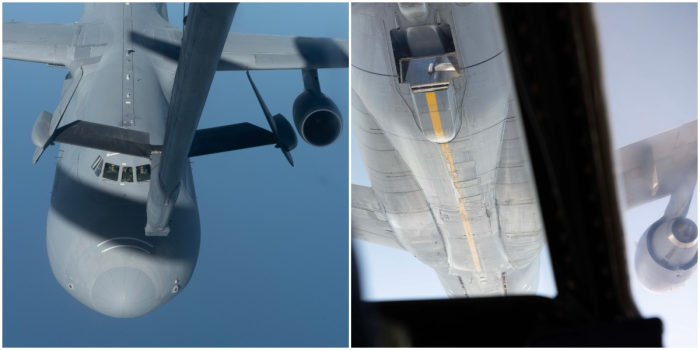In the ever-evolving theater of military aviation, the US Air Force has taken to the skies with an unconventional dance of fuel and flight. Picture this: a colossal C-5M Super Galaxy, typically tasked with heavy transport, playing the role of a mid-air gas station, refueling a KC-10 Extender tanker aircraft in a gravity-defying feat.
Born out of conceptual seeds planted in the 1920s, inflight refueling has morphed from a dangerous stunt into a linchpin of military prowess. The mission? To extend the wingspan of warplanes, addressing historical vulnerabilities that left bombers unescorted during World War II. This game-changing evolution also enables marathon missions, exemplified by the legendary Falklands War raid in 1982 when Vulcan bombers soared nonstop from England to the South Atlantic and back.

While the visual spectacle of aerial refueling remains reminiscent of Dr. Strangelove’s opening credits, beneath the surface, a technological evolution has unfolded over six decades. Autonomous systems now choreograph the aerial ballet, ensuring safety and efficiency. Yet, a lingering challenge persisted: how to refuel the refueler without sidelining critical tanker assets.
Enter the US Air Force’s 22nd Airlift Squadron (AS), introducing a groundbreaking concept that defies gravity and convention. On December 12, high above Northern California and Oregon, a C-5M Super Galaxy engaged in a seemingly routine refueling ballet with a KC-10 Extender. The twist? The C-5M reversed the traditional flow, channeling fuel into the waiting arms of the tanker. In approximately 30 minutes, 23,500 lb (10,700 kg) of fuel defied gravity, surging from transport to tanker.
Acknowledging the infancy of this daring endeavor, the Air Force views the recent demonstration as a data-gathering expedition to fine-tune this airborne waltz. Challenges loom, particularly in harmonizing the flight dynamics of two aircraft influenced by ever-shifting weights. Success, however, promises prolonged air missions with multiple aircraft operating at expanded ranges.

Major Justin Wilson, 22nd AS Chief of Standards and Evaluations and C-5M Evaluator Pilot, underscores the strategic significance: “By using a C-5 as a huge floating gas station, it allows more tankers to be positioned for offloading to fighter or mobility aircraft, versus having to use one tanker to refuel another, which takes away a tanker asset from the mission. This allows more tanker aircraft in the theater and extends their range or orbit time.”
In the vast expanse of the sky, innovation knows no bounds, and the US Air Force is rewriting the script of aerial refueling.


